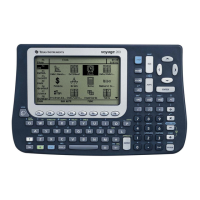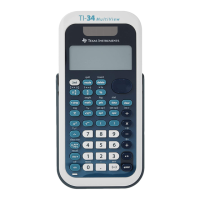850 Appendix A: Functions and Instructions
P4
44
4Rx() MATH/Angle menu
P4
44
4Rx(
rExpression
, q
Expression
) ⇒
⇒⇒
⇒
expression
P4
44
4Rx(
rList
, q
List
) ⇒
⇒⇒
⇒
list
P4
44
4Rx(
rMatrix
, q
Matrix
) ⇒
⇒⇒
⇒
matrix
Returns the equivalent x-coordinate of the
(r, q) pair.
Note: The q argument is interpreted as either a
degree, gradian or radian angle, according to the
current angle mode. If the argument is an
expression, you can use ó ,
G
or ô to override
the angle mode setting temporarily.
In Radian angle mode:
P
4Rx(r,q) ¸ cos(q)ø r
P
4Rx(4,60¡) ¸ 2
P
4Rx({ë 3,10,1.3},{p/3,ë p/4,0}) ¸
{
ë 3/2 5ø ‡2 1.3
}
P4
44
4Ry() MATH/Angle menu
P4
44
4Ry(
rExpression
, q
Expression
) ⇒
⇒⇒
⇒
expression
P4
44
4Ry(
rList
, q
List
) ⇒
⇒⇒
⇒
list
P4
44
4Ry(
rMatrix
, q
Matrix
) ⇒
⇒⇒
⇒
matrix
Returns the equivalent y-coordinate of the
(r, q) pair.
Note: The q argument is interpreted as either a
degree, gradian or radian angle, according to the
current angle mode. If the argument is an
expression, you can use ó ,
G
or ô to override
the angle mode setting temporarily.
In Radian angle mode:
P
4Ry(r,q) ¸ sin(q)ø r
P
4Ry(4,60¡) ¸
2
ø ‡3
P
4Ry({ë 3,10,1.3},{p/3,ë p/4,0}) ¸
{
ë 3ø ‡3
2
ë 5ø
‡
2
0.
}
part() CATALOG
part(
expression1
[ ,
nonNegativeInteger
])
This advanced programming function lets you
identify and extract all of the sub-expressions in
the simplified result of
expression1
.
For example, if
expression1
simplifies to
cos(pù x+3):
• The cos() function has one argument:
(pù x+3).
• The sum of (pù x+3) has two operands: pù x
and 3.
• The number 3 has no arguments or operands.
• The product pù x has two operands: p and x.
• The variable x and the symbolic constant p
have no arguments or operands.
If x has a numeric value and you press
¥¸,
the numeric value of pù x is calculated, the result
is added to 3, and then the cosine is calculated.
cos() is the top-level operator because it is
applied last.
part(
expression1
) ⇒
⇒⇒
⇒
number
Simplifies
expression1
and returns the number of
top-level arguments or operands. This returns 0 if
expression1
is a number, variable, or symbolic
constant such as p,
e
,
i
, or ˆ.
part(cos(pù x+3)) ¸ 1
Note: cos(pù x+3) has one argument.
part(
expression1
, 0) ⇒
⇒⇒
⇒
string
Simplifies
expression1
and returns a string that
contains the top-level function name or operator.
This returns
string(
expression1
) if
expression1
is a
number, variable, or symbolic constant such as p,
e
,
i
, or ˆ.
part(cos(pù x+3),0) ¸ "cos"

